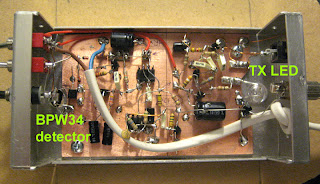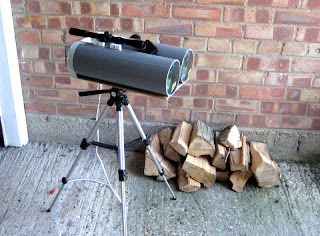This month I had two objectives:
(a) make my 10m halo into a dual band 10m/6m version.
(b) complete my 481THz optical speech transceiver.
Although a few days late, both objectives have been achieved with decent contacts on 10/6m and a 10.5km 2-way QSO on 481THz AM.
Several things will interrupt any objectives in the next month or so, but my next objectives are:
(a) Improve the sensitivity of my optical transceiver RX.
(b) Build a new transverter for the 472-479kHz band due to be released Jan 1st 2013 in the UK (we expect).
The first will allow me to use the dual-optics 481THz transceiver over longer paths. I hope to make some contacts over 20km in the next few months.
The second one (472kHz transverter) only needs to be completed before Christmas, but I'd like to get this moving soon. If possible I'd like to run the PA at around 20W - my earlier 500kHz transverter was just 5W - and to improve the RX sensitivity and selectivity. This new band will be a most interesting allocation and I expect quite a few stations to give it a try.
29 May 2012
28 May 2012
Joining the "over 10km" optical club
This morning I got a note from Stuart G8CYW which surprised me:
"Roger,So apparently very few of the people experimenting with 481THz red LED optical communications have broken the 10km barrier for 2-way QSOs. This surprised me. At the same time I am even more encouraged to continue this fascinating area of amateur radio as there is so much more I can do. The beauty of this is that test equipment needs are basic, skills needs well within my capabilities, and the results when success comes are extremely satisfying.
It has occurred to me that you have joined a "select" group, who have made an optical contact over 10km here in the UK with modulated LEDs. I had a quick count up of the people I know about and I do not think there are 10 yet. (probably more I do not know about though) .....so no small achievement."
27 May 2012
Multi-hop transatlantic Es on 10m
What I think is multi-hop Es propagation on 10m this evening allowed me a QRP contest exchange with NR4M in Virginia USA on CW at a late 2222z. Big contests show up these openings so it is worth some late evening WSPRing too when there are no contests running.
Despite the usually poor summertime conditions, Es can open up the band in surprising directions.
Despite the usually poor summertime conditions, Es can open up the band in surprising directions.
Labels:
10m,
28mhz,
nr4m,
sporadic-e
New LF Yahoo Group
After some debate, the old RSGB LF-reflector is now migrating to a new Yahoo group at http://uk.groups.yahoo.com/group/rsgb_lf_group/ . If you have an interest in the VLF/LF/MF amateur bands such as 8.97kHz, 136kHz, 472kHz and 500kHz then you may want to join. It is sure to become one of the most useful resources on the web for up-to-date information as well as a valuable archive of schematics, photos and ideas.
26 May 2012
My first 481THz 2-way QSO
 |
| The 481THz kit at the G3XBM/P end of the path |
Labels:
100mm,
481thz,
g4hjw,
optical transceiver,
red led
25 May 2012
481THz transceiver ready for QSOs
 |
| The electronics of the 481THz AM transceiver |
 | |
| The optics showing the 2-tube construction with sighting scope |
G4HJW is set up to do a 2-way test, so this is now likely to be attempted in the next few days. if successful I will then try to make a better, more permanent, version.
Labels:
481thz,
optical transceiver
23 May 2012
144MHz across the Atlantic?
A new beacon, GB3WGI in Ulster, has been approved by OFCOM. When turned on it will radiate at least 100W ERP (possibly much more) in the direction of the USA. It will be monitored in the USA and Canada for possible 144MHz openings across the Atlantic.
For many years people have speculated about the possibility of working across the Atlantic on 144MHz. On very rare occasions, this might be achieved by various propagation modes including multi-hop Es, auroral E, tropo or MS, or more probably a combination of these. There have been tantalising hints that this path has been open before now, but no objectively verifiable proof. With new weak signal modes it surely will happen sometime soon.
For many years people have speculated about the possibility of working across the Atlantic on 144MHz. On very rare occasions, this might be achieved by various propagation modes including multi-hop Es, auroral E, tropo or MS, or more probably a combination of these. There have been tantalising hints that this path has been open before now, but no objectively verifiable proof. With new weak signal modes it surely will happen sometime soon.
Labels:
144mhz,
beacon,
g4bao,
transatlantic
481THz optical transceiver progress
My AM baseband optical transceiver build is nearly finished (mechanics and electronics both almost complete), although I have to optimise the sensitivity as it is several dB less sensitive than my stand-alone optical receiver. I am not quite sure why. All being well I should be ready for a real QSO with fellow local optical enthusiast G4HJW next week.
Labels:
481thz,
optical transceiver
RSGB member for 50 years
When we got back from seeing our grandchildren in Kent today there was a small package from the RSGB on the doormat. I'd not ordered anything, so was a little puzzled what it might be.
Inside was a very nice letter and a personalised callsign RSGB lapel badge as a thank you for being a continuous RSGB member for 50 years this month. Apparently it was April 1962 when I first joined. It was very gratifying to get this: thank you RSGB!
Things have changed a great deal in the hobby since then, but there is as much, if not more, to enjoy today than back then. Whether I get to reach 60 years of membership remains to be seen but I certainly intend to do all I can to enjoy radio electronics for as long as I possibly can.
The RSGB has had a difficult recent history but it deserves our support so that it can work for UK radio amateurs in the years ahead.
Inside was a very nice letter and a personalised callsign RSGB lapel badge as a thank you for being a continuous RSGB member for 50 years this month. Apparently it was April 1962 when I first joined. It was very gratifying to get this: thank you RSGB!
Things have changed a great deal in the hobby since then, but there is as much, if not more, to enjoy today than back then. Whether I get to reach 60 years of membership remains to be seen but I certainly intend to do all I can to enjoy radio electronics for as long as I possibly can.
The RSGB has had a difficult recent history but it deserves our support so that it can work for UK radio amateurs in the years ahead.
20 May 2012
Finningley Optical Transceiver (G4HJW)
Bernie G4HJW is well known for his innovative microwave designs as well as many other good projects in recent years. This year he has produced another winner for the Finningley Round Table in mid July: a baseband optical transceiver kit designed with SMA components. For details see http://www.earf.co.uk/nanotrx.htm . I am not sure if Bernie is planning to make kits available more generally. Bernie has tested this design over a 65km line-of-sight path recently.
Labels:
finningley,
g4hjw,
optical transceiver,
round table,
sma
Subscribe to:
Posts (Atom)




